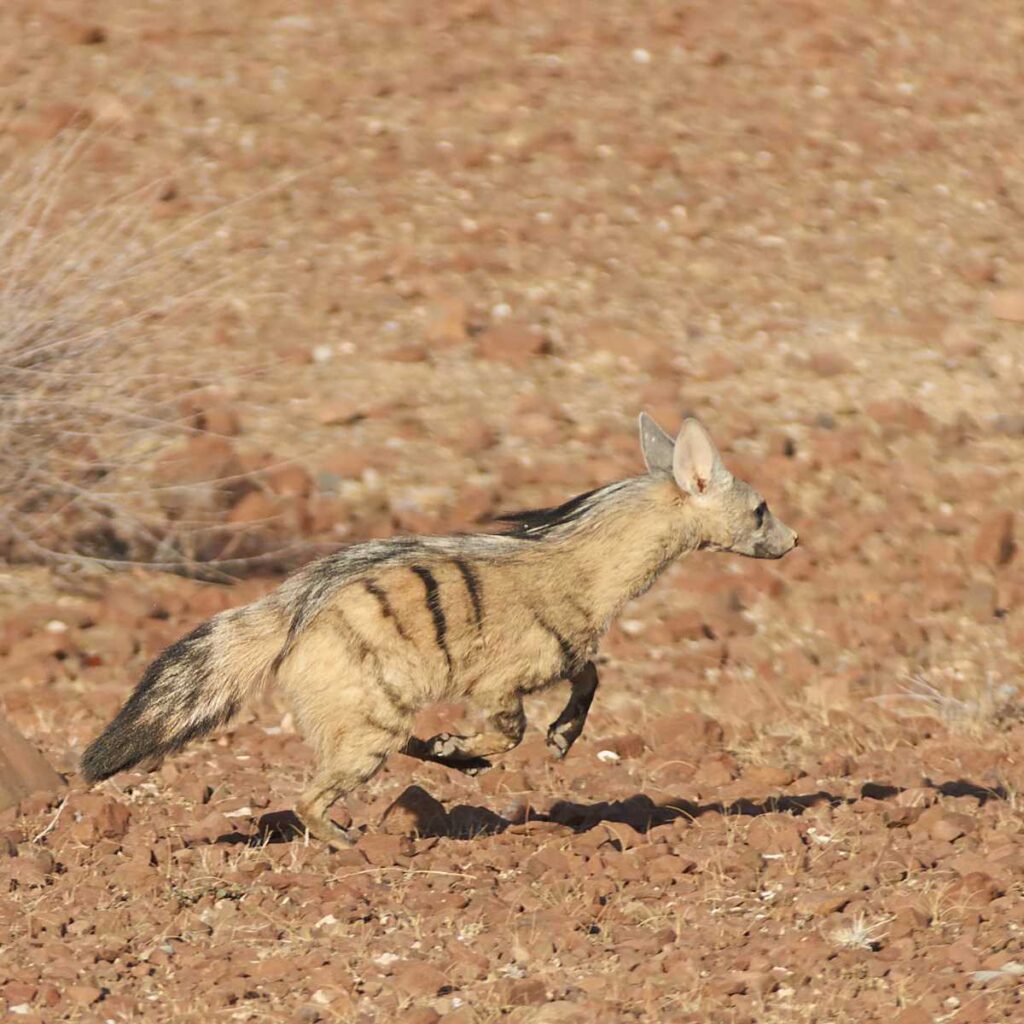Last Reviewed and Updated on January 18, 2023
The name might mislead you into believing aardwolf is part of the wolf family; aardwolves are an interesting species of hyena. Read on to learn a little bit more about this unique species and some of the fun facts about the aardwolf.

What is an aardwolf?
Before we explore some of the most interesting aardwolf facts, let’s go through some basic information about this species.
Aardwolf, a species of hyena, can only be found in Africa in the wild; more specifically, they can only be found in South and East Africa. They live in open, dry plains and bushland and only in regions abundant with termites.
While hyenas are known as meat-loving scavengers, a diet of the aardwolf separates them from most other members of the family; aardwolves are insectivores, meaning they mainly feed on bugs. They are most active during the night, making the aardwolf a nocturnal animal.
Visually an aardwolf resembles a thin striped hyena. However, the aardwolf does have a more slender muzzle. They have black stripes on a coat of yellow fur, with a longer mane running down the neck and back. The adult aardwolf is about 22 to 31 inches (55 to 80) centimeters long and 16 o 20 inches (40 to 50 cm) tall at the shoulders. The aardwolves in South Africa tend to be smaller and lighter than those in Eastern Africa.
They are solitary foragers (they feed alone) but aren’t solitary animals. They live as monogamous pairs with their young.
Regarding the aardwolf conservation status, they are considered the least concern species with healthy population numbers.
Facts About the Aardwolf
You already learned aardwolves aren’t wolves at all but are, in fact, part of the hyena family. But you can learn so much more about what makes this species unique. Read these facts about the aardwolf and discover what sets this species apart.

1. Aardwolf means Earth Wolf in the Afrikaans language
The name aardwolf means “earth wolf” in Afrikaans and Dutch.
2. They are the smallest hyena species
Of all the members of the Hyaenidae family, the aardwolves have the smallest build.
3. They may be the smallest, but they can make themselves a lot bigger
They avoid danger whenever possible; they aren’t the fastest runners and are not adept at fighting. Aardwolves may raise their mane to appear larger and more menacing if confronted.
4. They eat termites almost exclusively
While they will munch on other insects, larvae, and eggs (and by some accounts, small birds and lizards), the majority of aardwolf’s diet consists of termites, specifically the Trinervitermes termite genus. This group of termites is primarily nocturnal, which makes them perfect prey for aardwolves. Trinervitermes Trinervitermes build mounds above ground.
5. They can eat as many as 250.000 termites during a single night
They may be small when it comes to hyena species. However, they still are relatively big and active animals. To meet their dietary needs, they have to eat a lot of termites every night; they can eat as many as 250.000 termites in a single night.
When they forage for food, they don’t destroy the termite mounds, and they don’t eat the whole colony; this ensures the termites can rebuild their colonies and provide a continuous supply of food for aardwolves.
Due to their diet, they are sometimes also called the termite-eating hyena.
6. Scientists believed the aardwolf was only mimicking the striped hyena and that the species weren’t related
Aardwolf was formerly placed in its own family Protelidae as scientists believed the aardwolf was mimicking the striped hyena. Later studies suggested that aardwolves likely diverged from other hyenas early on, and the family Protelidae was changed to a subfamily Protelidae in the Hyaenidae family.
7. Unlike other hyenas, aardwolves have five toes on their front feet
Aardwolf’s front feet have five toes each, unlike the four-toed hyena. The name of the genus to which the aardwolves belong, the Proteles, describes this trait as it is derived from the Greek words protos and teleos, which together mean “complete in front.”
8. Aardwolf and aardvark are not related
Their names sound much alike, and they even share some similar traits, such as their diet, both being nocturnal and both being native to Africa. However, aardwolves and aardvarks are not closely related. Aardwolves are hyenas, and aardvarks are afrotheres, a group of animals more closely related to elephants, manatees, and hyraxes.
9. They have specialized cheek teeth
Their diet doesn’t require them to chew or tear their food, so their cheek teeth have adapted to their insect diet. Compared to other hyenas, their teeth are smaller, and their cheek teeth are flattened.
10. They aren’t keen on digging, but they do live in burrows
They can have up to 10 dens in their territory. Most of the aardwolves’ dens aren’t dug by them; they use abandoned aardvark, springhare, porcupine dens, and crevices in rocks. If the den doesn’t fit, they will dig to enlarge them. They can also dig their dens, but why bother if you can inhabit an abandoned one?
11. Aardwolves are very territorial but will make exceptions
Both male and females mark their territory, and intruders are not tolerated. If an intruder is spotted, an aardwolf will chase it away; if they catch the intruder, it may even end in a fight. But if the food is scarce, the territorial rules may be dropped, and as many as three pairs of aardwolves may share their territory.
12. Adult aardwolves burry their droppings
Aardwolves have numerous middens scattered across their territory. They deposit their droppings in these middens, dig holes in them, do their business, and then cover them with sand.
Young aardwolves don’t cover their droppings; they gradually adapt this behavior as they mature.
